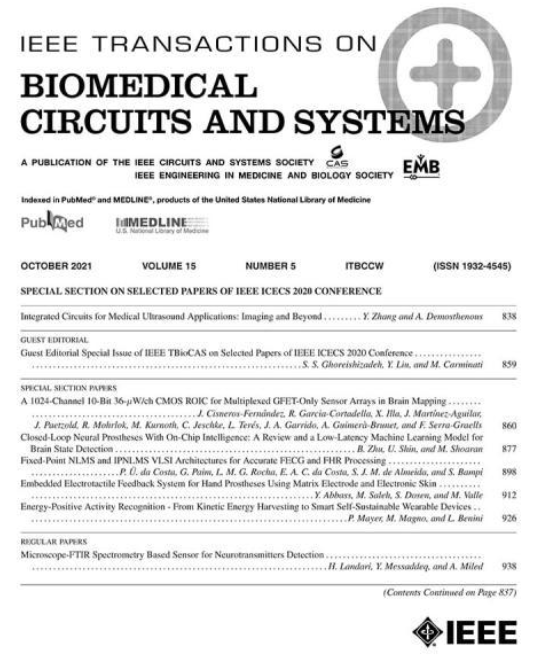基于先验信息的心电信号可变正交多匹配追踪无矩阵反演压缩感知
IF 4.9
2区 医学
Q2 ENGINEERING, BIOMEDICAL
IEEE Transactions on Biomedical Circuits and Systems
Pub Date : 2016-05-19
DOI:10.1109/TBCAS.2016.2539244
引用次数: 29
摘要
提出了一种在无线身体传感器网络(WBSN)中监测心电图信号的低复杂度压缩感知(CS)技术。首先利用小波域心电稀疏性的先验概率。然后,提出了由两阶段组成的可变正交多匹配追踪算法。在第一阶段,采用正交匹配追踪(OMP)算法对支持集进行可靠指标的有效扩充;在第二阶段,采用正交多匹配追踪(OMMP)算法对缺失指标进行拯救。利用先验信息和wmpp算法增强了重建性能。此外,利用基于QR分解的矩阵无反转(MIF)技术简化了计算量大的伪逆运算。然后在90纳米CMOS技术中实现了vOMMP-MIF CS解码器。QR分解是由两个收缩数组并行工作完成的。该实现支持三种设置,用于在稀疏向量中获得40、44和48个系数。从测量结果来看,在0.9 V和12 MHz下的功耗为11.7 mW。与先前的芯片实现相比,我们的设计显示出良好的硬件效率,适合低能耗应用。本文章由计算机程序翻译,如有差异,请以英文原文为准。
Matrix-Inversion-Free Compressed Sensing With Variable Orthogonal Multi-Matching Pursuit Based on Prior Information for ECG Signals
Low-complexity compressed sensing (CS) techniques for monitoring electrocardiogram (ECG) signals in wireless body sensor network (WBSN) are presented. The prior probability of ECG sparsity in the wavelet domain is first exploited. Then, variable orthogonal multi-matching pursuit (vOMMP) algorithm that consists of two phases is proposed. In the first phase, orthogonal matching pursuit (OMP) algorithm is adopted to effectively augment the support set with reliable indices and in the second phase, the orthogonal multi-matching pursuit (OMMP) is employed to rescue the missing indices. The reconstruction performance is thus enhanced with the prior information and the vOMMP algorithm. Furthermore, the computation-intensive pseudo-inverse operation is simplified by the matrix-inversion-free (MIF) technique based on QR decomposition. The vOMMP-MIF CS decoder is then implemented in 90 nm CMOS technology. The QR decomposition is accomplished by two systolic arrays working in parallel. The implementation supports three settings for obtaining 40, 44, and 48 coefficients in the sparse vector. From the measurement result, the power consumption is 11.7 mW at 0.9 V and 12 MHz. Compared to prior chip implementations, our design shows good hardware efficiency and is suitable for low-energy applications.
求助全文
通过发布文献求助,成功后即可免费获取论文全文。
去求助
来源期刊

IEEE Transactions on Biomedical Circuits and Systems
工程技术-工程:电子与电气
CiteScore
10.00
自引率
13.70%
发文量
174
审稿时长
3 months
期刊介绍:
The IEEE Transactions on Biomedical Circuits and Systems addresses areas at the crossroads of Circuits and Systems and Life Sciences. The main emphasis is on microelectronic issues in a wide range of applications found in life sciences, physical sciences and engineering. The primary goal of the journal is to bridge the unique scientific and technical activities of the Circuits and Systems Society to a wide variety of related areas such as: • Bioelectronics • Implantable and wearable electronics like cochlear and retinal prosthesis, motor control, etc. • Biotechnology sensor circuits, integrated systems, and networks • Micropower imaging technology • BioMEMS • Lab-on-chip Bio-nanotechnology • Organic Semiconductors • Biomedical Engineering • Genomics and Proteomics • Neuromorphic Engineering • Smart sensors • Low power micro- and nanoelectronics • Mixed-mode system-on-chip • Wireless technology • Gene circuits and molecular circuits • System biology • Brain science and engineering: such as neuro-informatics, neural prosthesis, cognitive engineering, brain computer interface • Healthcare: information technology for biomedical, epidemiology, and other related life science applications. General, theoretical, and application-oriented papers in the abovementioned technical areas with a Circuits and Systems perspective are encouraged to publish in TBioCAS. Of special interest are biomedical-oriented papers with a Circuits and Systems angle.
 求助内容:
求助内容: 应助结果提醒方式:
应助结果提醒方式:


